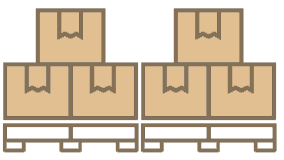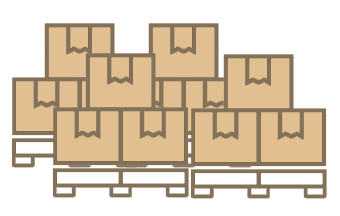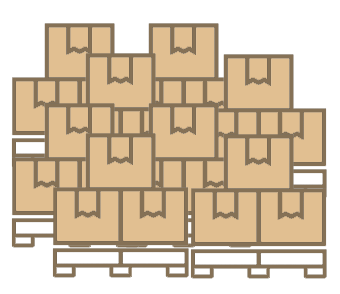Wondering whether your domestic freight shipment should move via parcel, less-than-truckload (LTL), or full-truckload (FTL) carrier? Here’s a quick cheat-sheet with some PROs and CONs to each of these ground transportation modes.
 Parcel Shipping: Shipments under 150 pounds and shipped in cartons (less than 108 inches long and 67 inches wide), rather than on a pallet, are often moved via Parcel shipping with carriers such as USPS, UPS, FedEx or regional courier services.
Parcel Shipping: Shipments under 150 pounds and shipped in cartons (less than 108 inches long and 67 inches wide), rather than on a pallet, are often moved via Parcel shipping with carriers such as USPS, UPS, FedEx or regional courier services.
- PROS: Fast service, many delivery options, readily available, lower shipping costs on smaller shipments.
- CONS: More chance of being lost or damaged, lower carrier liability limits per pound, few carrier options.
 Standard Less-Than-Truckload (LTL) Shipping: Shipments between 150 and 5,000 pounds are generally better moved using standard LTL carrier pricing with LTL carriers such as FedEx Freight, UPS Freight, YRC Freight, or regional freight carriers.
Standard Less-Than-Truckload (LTL) Shipping: Shipments between 150 and 5,000 pounds are generally better moved using standard LTL carrier pricing with LTL carriers such as FedEx Freight, UPS Freight, YRC Freight, or regional freight carriers.
- PROS: Relatively fast service, good availability, fewer damages, good with B2B deliveries, higher carrier liability limits pound.
- CONS: Complex pricing structure, higher shipping costs, not always suitable for non-palletized freight, not always great with B2C deliveries, minimal carrier options.
 Volume Less-Than-Truckload (LTL) Shipping: Shipments between 5,000 and 10,000 pounds, or taking up more than 6 pallet spaces, are often moved more cost-effectively with a “volume” or “spot” quote. In these situations, the carrier will analyze the weight and dimensions of the shipment and provide a competitive “all-in” rate quote.
Volume Less-Than-Truckload (LTL) Shipping: Shipments between 5,000 and 10,000 pounds, or taking up more than 6 pallet spaces, are often moved more cost-effectively with a “volume” or “spot” quote. In these situations, the carrier will analyze the weight and dimensions of the shipment and provide a competitive “all-in” rate quote.
- PROS: All of the above, plus this approach will generally produce a lower price than standard LTL shipping rates.
- CONS: Often predicated on when or where LTL carrier has equipment available and need for more freight volume, getting quotes takes more time.
 Partial Truckload Shipping: Shipments between 10,000 and 20,000 pounds, or taking up more than 10 pallet spaces, are often moved more cost-effectively as a partial truckload. In these situations, the truckload carrier will analyze the weight and dimensions of the shipment and provide a competitive “all-in” rate quote.
Partial Truckload Shipping: Shipments between 10,000 and 20,000 pounds, or taking up more than 10 pallet spaces, are often moved more cost-effectively as a partial truckload. In these situations, the truckload carrier will analyze the weight and dimensions of the shipment and provide a competitive “all-in” rate quote.
- PROS: Generally produces a lower pricing than standard or volume LTL shipping rates, since shipment only takes up part of the trailer, carrier can sell remaining capacity to another customer to share the costs, many more carrier options.
- CONS: Finding right carrier with capacity is often difficult, predicated on when or where carrier has equipment available, getting quotes takes more time, must vet carrier to ensure safe and reliable.
 Full Truckload (FTL) Shipping: Shipments over 20,000 pounds are often moved more cost-effectively as a full truckload. In these situations, the carrier will analyze the weight and dimensions of the shipment and provide a competitive “all-in” rate quote.
Full Truckload (FTL) Shipping: Shipments over 20,000 pounds are often moved more cost-effectively as a full truckload. In these situations, the carrier will analyze the weight and dimensions of the shipment and provide a competitive “all-in” rate quote.
- PROS: Generally the most cost-effective way to ship per pound, less susceptible to damages because freight is normally moved door-to-door on one trailer (no re-handlings), many more carrier options.
- CONS: Finding right carrier with capacity is often difficult, predicated on when or where carrier has equipment available, getting quotes take more time, must vet carrier to ensure safe and reliable.
Need help deciding how best to ship your freight the most using the most cost-effective ground transportation mode? Let Logistics Plus help you with a risk-free freight analysis or freight quote.


